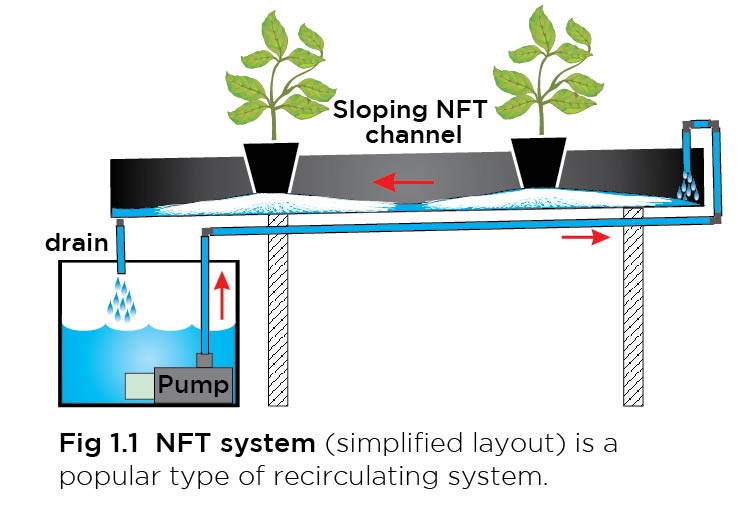Guide to Hydroponic System Design: Recirculating or Run-to-waste?
Good system design is vital for producing consistent and reliable growth. What works best for you will depend on factors such as climate, plant type, water quality, growing medium availability, maintenance requirements, set-up costs, and whether you are growing indoors or outdoors.
Recirculating systems
In a recirculating system the nutrient solution is pumped from a reservoir to the plant’s roots. The excess nutrient is then allowed to drain back to the same reservoir (Fig 1.1). This permits reuse of the nutrient solution until it is either depleted of useful elements or is contaminated. The nutrient solution is then discarded and replaced with fresh nutrient. There are several types of recirculating systems in use. Popular types include nutrient film technique (NFT – Fig 1.1), Flood & drain (Ebb & flow – Fig 1.2), aeroponics and satellite systems.
Advantages of recirculating systems
- Lower water and nutrient consumption.
- Relatively easy to disinfect roots and hardware.
- Regular feeding (and associated flushing) prevents localised salt build-up in the root zone and maintains uniform root zone pH and conductivity.
- Environmentally friendly – minimal potential for localised groundwater contamination.
Run-to-waste systems
“Run-to-waste” describes those systems where the excess nutrient or “run-off” is not re-circulated. Conventional ‘soil culture’ is a type of run-to-waste system.
- Media with a high water holding capacity are used (e.g. soil, coconut fibre, Rockwool).
- Feeds are small and infrequent.
- The ‘run-off’ is either drained directly onto the ground (Fig 1.3) or is collected (Fig 1.4).
- Irrespective of whether the nutrient is collected or drained directly onto the ground, plain water flushes are usually needed at frequent intervals through the same plumbing. This helps minimize salt build-up in the root zone and also helps keep the feed circuit free of blockages.

Advantages of run-to-waste systems
- pH and EC of the nutrient feed solution is stable.
- Plants receive fresh nutrient at each feed.
- The use of media having high water holding capacity minimizes the risk of plant death in the event of nutrient pump failure.
- In the event of root disease outbreak, there is less risk of cross contamination between pots or trays because the nutrient is not recirculated.
- Can be an advantage for higher salinity waters. Unlike recirculating systems, salinity does not build-up in the nutrient solution.
For more see page 6 of the FloraMax Hydroponics Manual.
© Andrew M Taylor

